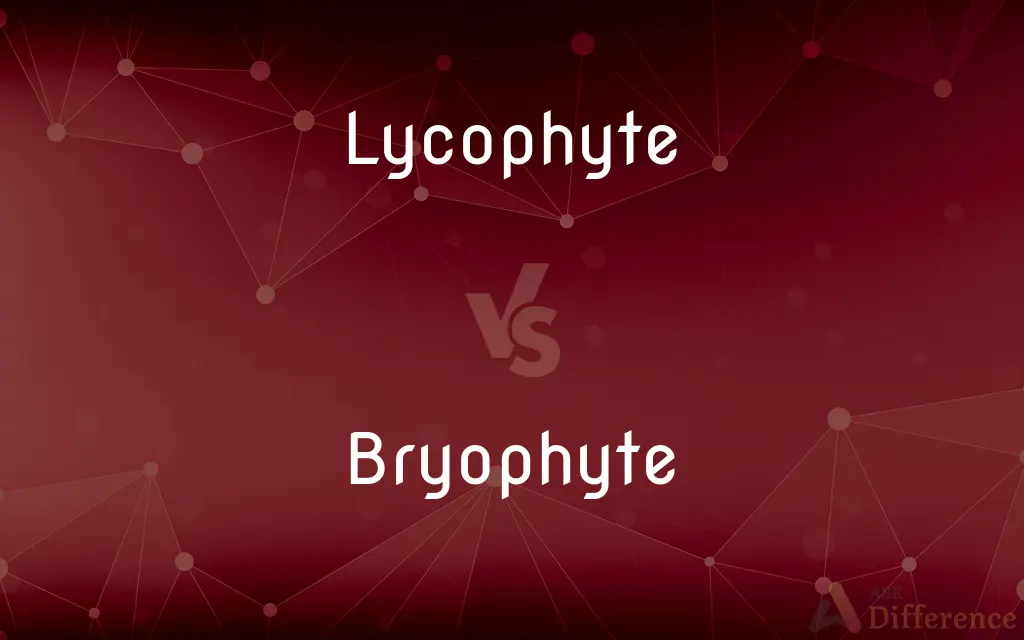Lycophyte vs. Bryophyte — What's the Difference?
Edited by Tayyaba Rehman — By Urooj Arif — Updated on April 9, 2024
Lycophytes are ancient vascular plants with roots and leaves, while bryophytes are non-vascular plants, like mosses, lacking true roots and leaves.

Difference Between Lycophyte and Bryophyte
Table of Contents
ADVERTISEMENT
Key Differences
Lycophytes, including club mosses, spike mosses, and quillworts, are among the oldest groups of vascular plants, characterized by having specialized tissues for water and nutrient transport. These plants possess true roots, stems, and small, scale-like leaves called microphylls. Whereas, bryophytes, which encompass mosses, liverworts, and hornworts, lack these vascular tissues, and instead of true roots, they have rhizoids for anchoring.
The reproductive strategies of lycophytes involve the production of spores in structures called sporangia, located on the underside of leaves or at the tips of stems. They have a complex life cycle with distinct sporophyte and gametophyte stages. On the other hand, bryophytes also reproduce through spores, but their dominant life stage is the gametophyte, which is the green, photosynthetic part we commonly see, unlike lycophytes where the sporophyte is dominant.
Lycophytes are adapted to a variety of habitats but are most commonly found in tropical and subtropical regions, as well as in temperate forests and mountains. They require moist environments to facilitate the movement of sperm to eggs during reproduction. Bryophytes, on the other hand, are even more dependent on water for reproduction and are commonly found in moist, shaded environments. They can also survive in extreme environments where vascular plants cannot, such as on rocks and in arctic tundra.
While lycophytes have a more complex structure and can grow larger due to their vascular systems, bryophytes are generally smaller, ground-hugging plants. The absence of vascular tissue in bryophytes limits their size and the environments they can inhabit. However, this also allows them to occupy niches that are inaccessible to larger plants, playing crucial roles in ecosystems, such as preventing soil erosion and serving as indicators of environmental health.
The fossil record shows that ancient lycophytes were much larger and formed significant parts of the world's forests during the Carboniferous period. Modern lycophytes are much smaller, but they provide insights into plant evolution and the transition from non-vascular to vascular plants. Bryophytes, while also ancient, have remained small and non-vascular, showing how plants have adapted to fill various ecological niches over millions of years.
ADVERTISEMENT
Comparison Chart
Vascular System
Present (with roots, stems, and leaves)
Absent (no true roots or leaves)
Dominant Life Stage
Sporophyte
Gametophyte
Reproduction
Spores produced in sporangia
Spores, with a heavy reliance on water
Habitat
Tropical, subtropical, temperate forests
Moist, shaded environments; can be more varied
Size and Structure
Larger, with microphylls (small leaves)
Smaller, ground-hugging plants
Environmental Role
Adapted to moist environments
Prevent soil erosion, indicate environmental health
Compare with Definitions
Lycophyte
Reproduces via spores in sporangia.
The sporangia of spike mosses are often found on the underside of leaves.
Bryophyte
Non-vascular plants including mosses, liverworts, and hornworts.
The moss carpeting the forest floor is a type of bryophyte.
Lycophyte
Found in moist, often shaded habitats.
Lycophytes are abundant in the understory of temperate forests.
Bryophyte
Reproduces with spores, requiring water for fertilization.
Mosses release spores that need water to reach other gametophytes for fertilization.
Lycophyte
A group of ancient vascular plants with specialized tissues.
The quillwort, a type of lycophyte, thrives in aquatic environments.
Bryophyte
Thrives in moist, shaded areas and diverse environments.
Bryophytes are often found in damp, shaded locations like woods and stream banks.
Lycophyte
Dominant life stage is the sporophyte.
In lycophytes, the sporophyte generation is what we commonly observe.
Bryophyte
Lacks true roots, using rhizoids for anchoring.
Liverworts use rhizoids to anchor themselves to rocks and soil.
Lycophyte
Characterized by true roots, stems, and microphylls.
Club mosses, easily recognized by their scale-like leaves, are common lycophytes.
Bryophyte
Dominant life stage is the gametophyte.
The green, leafy part of moss is the gametophyte stage.
Lycophyte
The lycophytes, when broadly circumscribed, are a vascular plant (tracheophyte) subgroup of the kingdom Plantae. They are sometimes placed in a division Lycopodiophyta or Lycophyta or in a subdivision Lycopodiophytina.
Bryophyte
Bryophytes are a hypothetical taxonomic division containing three groups of non-vascular land plants (embryophytes): the liverworts, hornworts and mosses. They are characteristically limited in size and prefer moist habitats although they can survive in drier environments.
Lycophyte
(botany) Any plant (such as the club mosses) that is a member of the division Lycophyta (or Lycopodiophyta)
Bryophyte
Any of numerous photosynthetic, chiefly terrestrial, nonvascular plants that reproduce by spores, including the mosses, liverworts, and hornworts. These three groups together formerly made up the division Bryophyta, which is now restricted to the mosses alone.
Bryophyte
(botany) Any plant of the division Bryophyta, defined sensu lato to comprise the mosses, liverworts and hornworts and corresponding to all embryophytes that are not vascular plants.
Bryophyte
Any of numerous plants of the division Bryophyta.
Bryophyte
Any of numerous plants of the division Bryophyta
Common Curiosities
What is the main difference between lycophytes and bryophytes?
Lycophytes are vascular plants with specialized tissues, while bryophytes are non-vascular, lacking true roots and leaves.
Can both lycophytes and bryophytes reproduce with seeds?
No, both reproduce via spores; they do not produce seeds.
Why are bryophytes smaller than lycophytes?
The lack of vascular tissue in bryophytes limits their size and growth capacity.
What habitats do lycophytes prefer?
They prefer moist environments such as tropical forests and temperate woodlands.
How do bryophytes contribute to the environment?
They prevent soil erosion and can indicate the health of the environment.
Can lycophytes live in water?
Some, like quillworts, are adapted to aquatic environments.
What makes lycophytes distinct from other vascular plants?
Their presence of microphylls and early evolution among vascular plants.
How do bryophytes and lycophytes differ in their reproductive mechanisms?
Both use spores, but bryophytes rely more on water for the movement of sperm to eggs.
Are bryophytes important for ecosystems?
Yes, they play crucial roles in water retention, soil formation, and as habitat for microorganisms.
Do bryophytes need soil to grow?
Not necessarily; they can grow on rocks, trees, and other surfaces where moisture is available.
Why do lycophytes have a complex life cycle?
Their life cycle includes distinct sporophyte and gametophyte stages, allowing for adaptation to various environments.
Share Your Discovery

Previous Comparison
Region vs. Place
Next Comparison
Film vs. RecordAuthor Spotlight
Written by
Urooj ArifUrooj is a skilled content writer at Ask Difference, known for her exceptional ability to simplify complex topics into engaging and informative content. With a passion for research and a flair for clear, concise writing, she consistently delivers articles that resonate with our diverse audience.
Edited by
Tayyaba RehmanTayyaba Rehman is a distinguished writer, currently serving as a primary contributor to askdifference.com. As a researcher in semantics and etymology, Tayyaba's passion for the complexity of languages and their distinctions has found a perfect home on the platform. Tayyaba delves into the intricacies of language, distinguishing between commonly confused words and phrases, thereby providing clarity for readers worldwide.















































